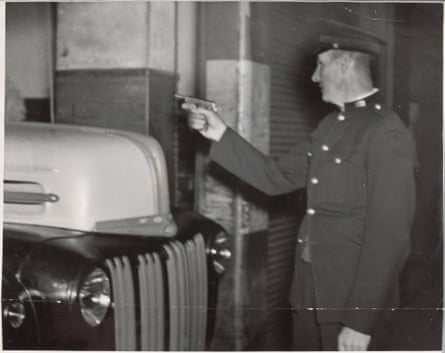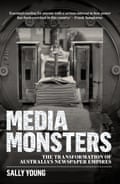Eighty years ago, in September 1943, Australia’s newspaper owners feared the worst when Labor’s Arthur Calwell was sworn in as minister for information in John Curtin’s wartime government.
Unlike most politicians, the federal member for Melbourne relished fighting with the press. Calwell’s political career had begun with a libel action against a newspaper – and it would end the same way three decades later.
Two years before he was sworn in as minister, Calwell famously said that the Australian press is “owned for the most part by financial crooks and is edited for the most part by mental harlots”.
A tough political brawler with a legendary ability to hold a grudge, no other government minister ever gave newspaper owners as much trouble. When Curtin set sail for the United States in early April 1944, he had not even arrived before Sydney’s daily newspapers were suppressed at gunpoint with Calwell’s permission. This set off the most dramatic incident in Australian press history.
For months beforehand, newspaper proprietors had complained that wartime censorship was being applied in a heavy-handed, inconsistent and politically motivated manner.
In Sydney, the censors were taking a broad view of censorship and censoring material they felt was damaging to public morale or Australia’s reputation, viewing this as harmful to the war effort. Frank Packer’s Daily Telegraph, no friend of the Labor government, had especially been keeping the censors busy by publishing material on strikes and harsh criticisms of government ministers.
Calwell had dismissed proprietors’ complaints as the griping of overprivileged and unpatriotic newspaper barons. He taunted that newspapers were the biggest censors of all as they routinely censored opposing political views or any news critical of their large advertisers, friends, family or club colleagues.
Getting nowhere with Calwell, the Sydney papers consulted with their lawyers and decided the best way to achieve reform and put Calwell in his place was to overtly challenge the censors.
Fighting back was principally Packer’s initiative, but he had Rupert Henderson, general manager of the rival Sydney Morning Herald, on side.
In mid-April, once Curtin was safely out of the country, Henderson made a public statement listing examples of what he called “political censorship”. Under censorship regulations, it was forbidden to reveal that censorship had taken place by disclosing examples of it or showing any alterations to copy.
In defiance of censorship rules, on Saturday 15 April, the Daily Telegraph printed Henderson’s statement on page three with blank spaces to make it obvious where long passages had been deleted by the censor. That night, the major Sydney paper owners and executives, along with two constitutional lawyers, met at the Daily Telegraph office to discuss their next move.
After the visitors left, Packer’s Sunday Telegraph defied the censor again. Its first edition on 16 April had two empty columns on its front page and a blank column on page three.

Later that day, senior representatives from Sydney’s four major newspaper groups met again, joined by nine barristers, including five King’s Counsel.
According to the meeting notes, Rupert Henderson said, “Our desire is to get the regulations tested [by the high court]. We need to bowl up something which we know [the censor] will censor, and we know by our advice that he has no right to do so.” The papers agreed to go “One in, all in” and to “stand or fall together”.
The colourful Daily Telegraph editor Brian Penton, who despised Calwell, prepared a joint statement to be published by all of the Sydney daily papers the next day. It included a reference to Calwell as Joseph Goebbels, the hated Nazi propagandist, which had already been censored and was bound to do the trick if repeated.
That night, in the early hours, the director general of information, EG Bonney, became aware of the newspapers’ plan for joint rebellion. He decided to seize the papers. He contacted Calwell, who later recalled in his autobiography telling Bonney, “Well, if you go ahead, I will support you in all you do and accept full ministerial responsibility for everything you do.”
Commonwealth peace officers (an early version of federal police) arrived at the Sydney Morning Herald around midnight. The presses were stopped and trucks loaded with papers were prevented from leaving.
At the Daily Telegraph office, workers smuggled out a few thousand copies of the paper before peace officers stood in front of loaded trucks. Packer had a photographer at the ready.
Bridget Griffen-Foley, a historian, explained how the defining image of the conflict came about. The Daily Telegraph’s police roundsman, Alec Boyd, goaded one of the inexperienced peace officers about what he would do if a driver tried to leave the loading dock. Boyd insisted, “Show us what you’d do, you know. Get your gun out and show us.” The hapless officer pulled out his pistol.

Unaware of all this overnight drama, Sydneysiders woke on Monday 17 April 1944 to find there were no morning newspapers on their doorstep or at newspaper kiosks dotted around the city.
People were baffled. The only indication of what had happened were street posters saying: “TELEGRAPH BANNED: POLITICAL CENSORSHIP.”
In the afternoon, commonwealth peace officers also arrived at the offices of the two afternoon newspapers, the Sun and the Daily Mirror, to seize their early editions.
At the Sun, employees ran upstairs and threw copies down from the windows to people gathered in Elizabeth Street, making a colourful scene of paper floating from the sky. At the Daily Mirror office, a peace officer again drew a gun to stop a truck leaving but he was brushed aside by workers.
Among the lucky citizens who managed to get their paper on 17 April were several high court judges. Packer had arranged for smuggled-out copies to be delivered early to their homes. That day, by a majority of three to two, the high court granted an interim injunction restraining censorship authorities from interfering with the papers’ publication.
The government could have fought a legal battle from here, and may have been successful as wartime powers were extensive, but the newspapers were always going to win in the court of public opinion.
The government added a new “code of censorship principles” that said censorship should be used “exclusively for reasons of defence security”.

The newspapers had sent a message about their joint political power that would serve as a warning to politicians for decades to come. They also did all they could to damage Calwell’s public image by minimising his achievements, ridiculing him and caricaturing him as an angry cockatoo.
According to Calwell’s biographer, Colm Kiernan, this revenge campaign by the press denied Calwell his chance of leading the Labor party in 1951 after the death of Curtin’s successor, Ben Chifley. Calwell would later become Labor leader, but he would never become prime minister. The man who stopped the papers felt that, in the end, he was stopped by them.

